1993 CHEVROLET BLAZER automatic transmission
[x] Cancel search: automatic transmissionPage 64 of 386
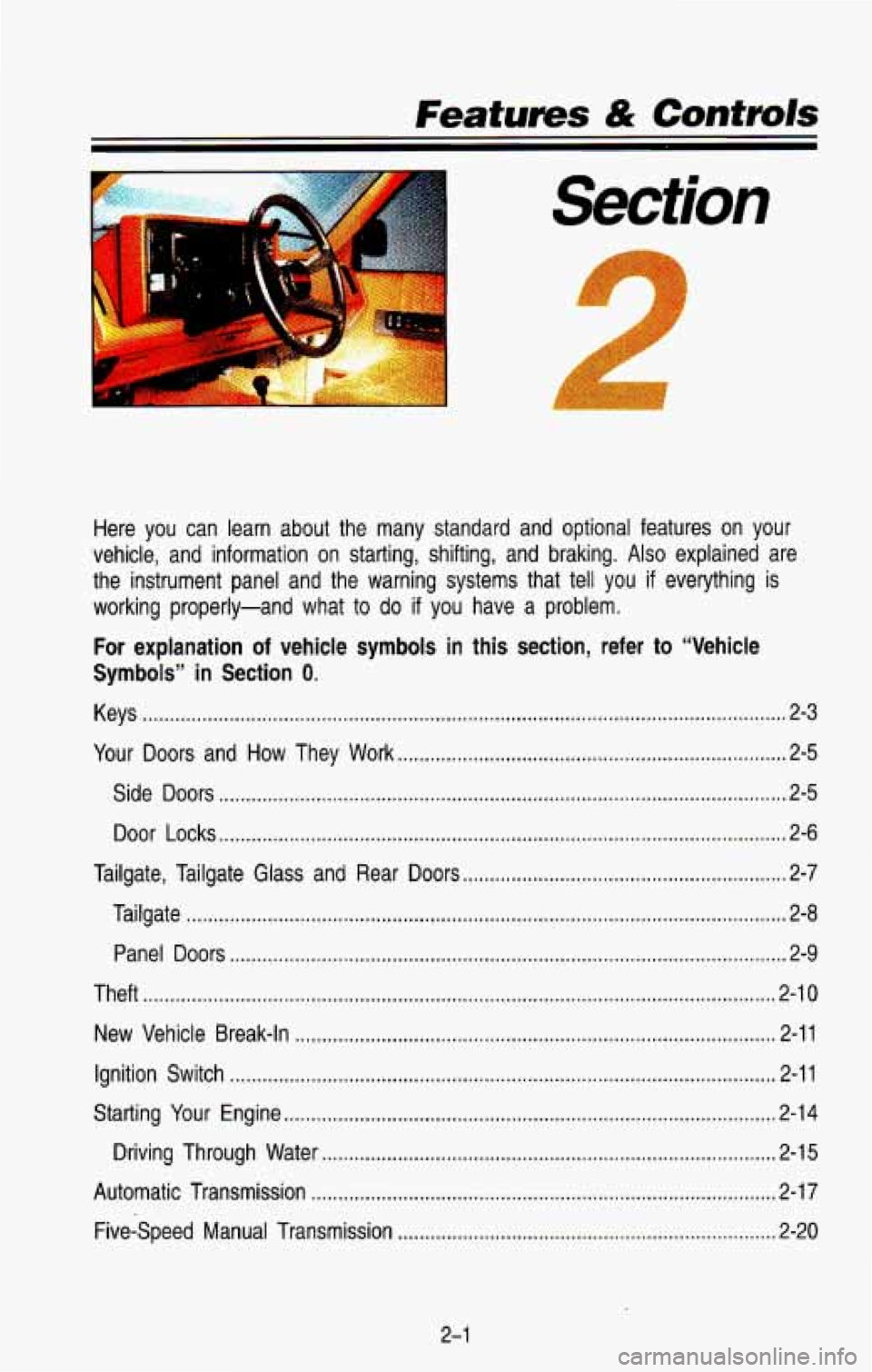
. Featums & Controls
I
Section
Here you can learn about the many standard and optional featur\
es on your
vehicle. and information on starting. shifting. and braking
. Also explained are
the instrument panel and the warning systems that tell you
if everything is
working properly-and what to do if you have a problem
.
For explanation of vehicle symbols in this section. refer to “Vehicle
Symbols” in Section 0 .
Keys ........................................................................\
............................................... 2-3
Your DobrS and How They Work
........................................................................\
2-5
Side Doors
........................................................................\
................................. 2-5
Door Locks
........................................................................\
................................. 2-6
Tailgate. Tailgate Glass and Rear Doors
............................................................ 2-7
Tailgate
........................................................................\
....................................... 2-8
Panel Doors ........................................................................\
............................... 2-9
Theft
........................................................................\
............................................. 2-10
New Vehicle Break-In
........................................................................\
................. 2-11
Ignition Switch
........................................................................\
............................. 2-11
Starting Your Engine ........................................................................\
................... 2-14
Driving Through Water
........................................................................\
............ 2-15
Automatic Transmission
........................................................................\
.............. 2-17
Five-Speed Manual Transmission ...................................................................... 2-20
2-1
Page 73 of 386
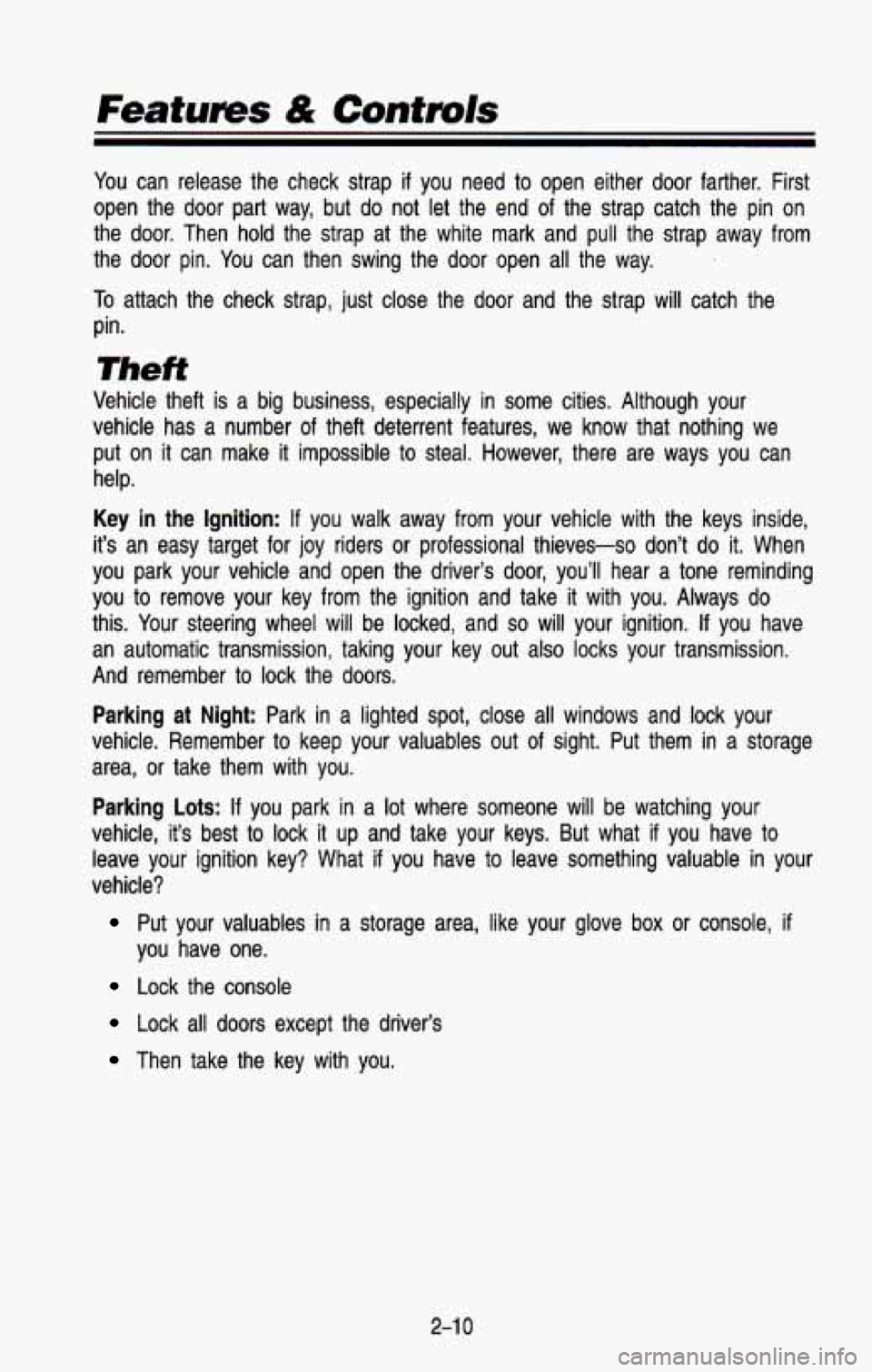
Features & Contmls
You can release the check strap if you need to open either door farther. First
open the door part way, but do not let the end of the strap catch the pin on
the
door. Then hold the strap at the white mark and pull the strap away from
the door pin. You can then swing the door open all the way.
To attach the check strap, just close the door and the strap wil\
l catch the
pin.
Theft
Vehicle theft is a big business, especially in some cities. Although your
vehicle has a number of theft deterrent features, we know that nothing we
put on it can make
it impossible to steal. However, there are ways you can
help.
Key in the Ignition: If you walk away from your vehicle with the keys inside,
it’s an easy target for joy riders or professional thieves-so don’t do it. When
you park
your vehicle and open the driver‘s door, you’ll hear a tone r\
eminding
you to remove your key from the ignition and take it with you. Always do
this. Your steering wheel will be locked, and
so will your ignition. If you have
an automatic transmission, taking your key out also locks your transmission.
And remember to lock the doors.
Parking at Night: Park in a lighted spot, close all windows and lock your
vehicle, Remember to keep your valuables out of sight. Put them
in a storage
area, or take them with you.
Parking Lots: If you park in a lot where someone will be watching your
vehicle, it’s best to lock it up and take your keys. But what
if you have to
leave your ignition key? What
if you have to leave something valuable in your
vehicle?
Put your valuables in a storage area, like your glove box or console, if
you have one.
Lock the console
Lock all doors except the driver’s
Then take the key with you.
2-1 0
Page 76 of 386
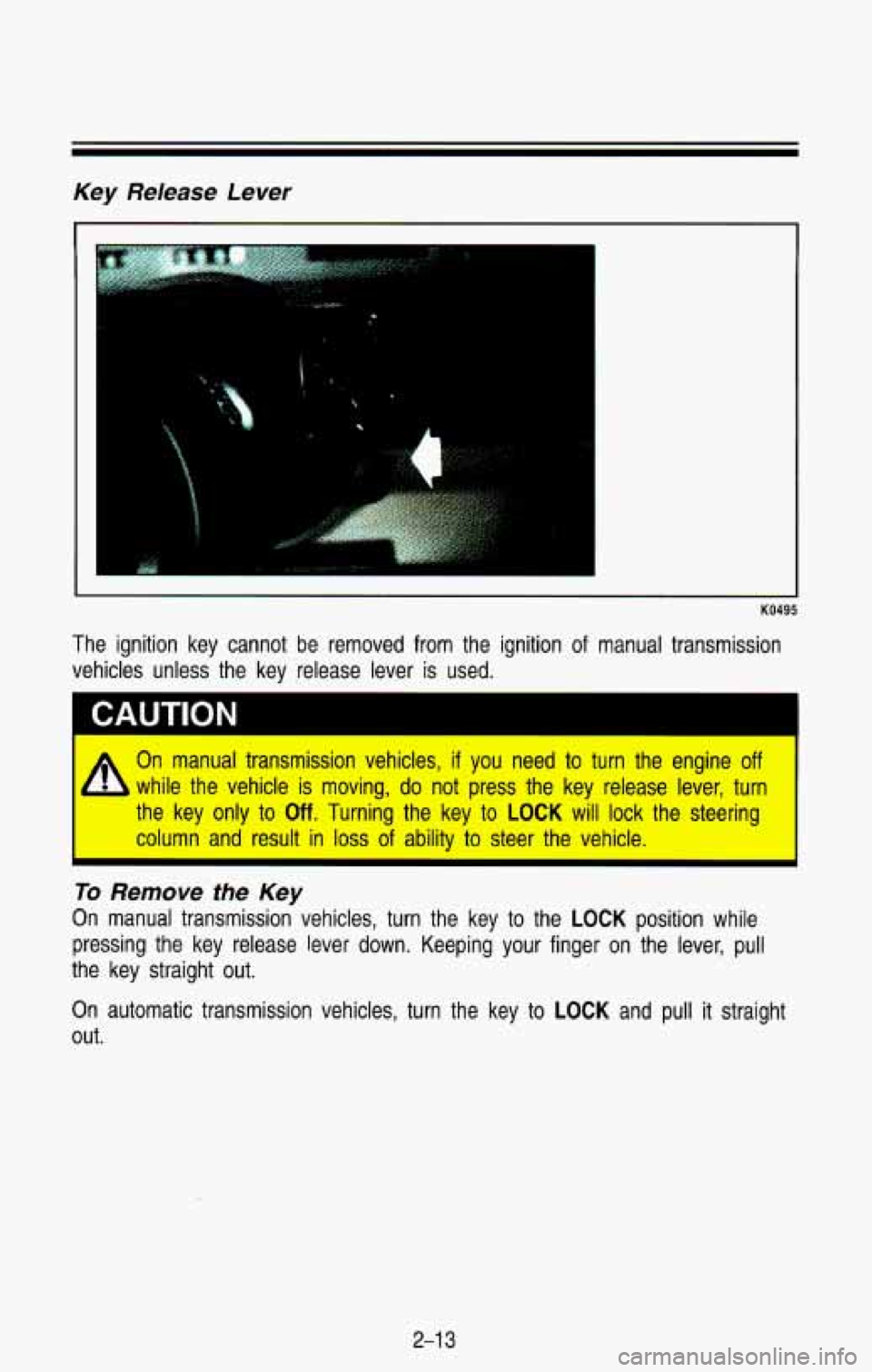
Key Release Lever
I
KO495
The ignition key cannot be removed from the ignition of manual transmission
vehicles unless the key release lever is used.
I
A
On manual transmission vehicles, if you need to turn the engine off
while the vehicle is moving, do not press the key release lever, turn
the key only to
Off. Turning the key to LOCK will lock the steering
column and result in
loss of ability to steer the vehicle. I
I
To Remove the Key
On manual transmission vehicles, turn the key to the LOCK position while
pressing the key release lever down. Keeping your finger on th\
e lever, pull
the key straight out.
On automatic transmission vehicles, turn the key to
LOCK and pull it straight
out.
2-1 3
Page 77 of 386
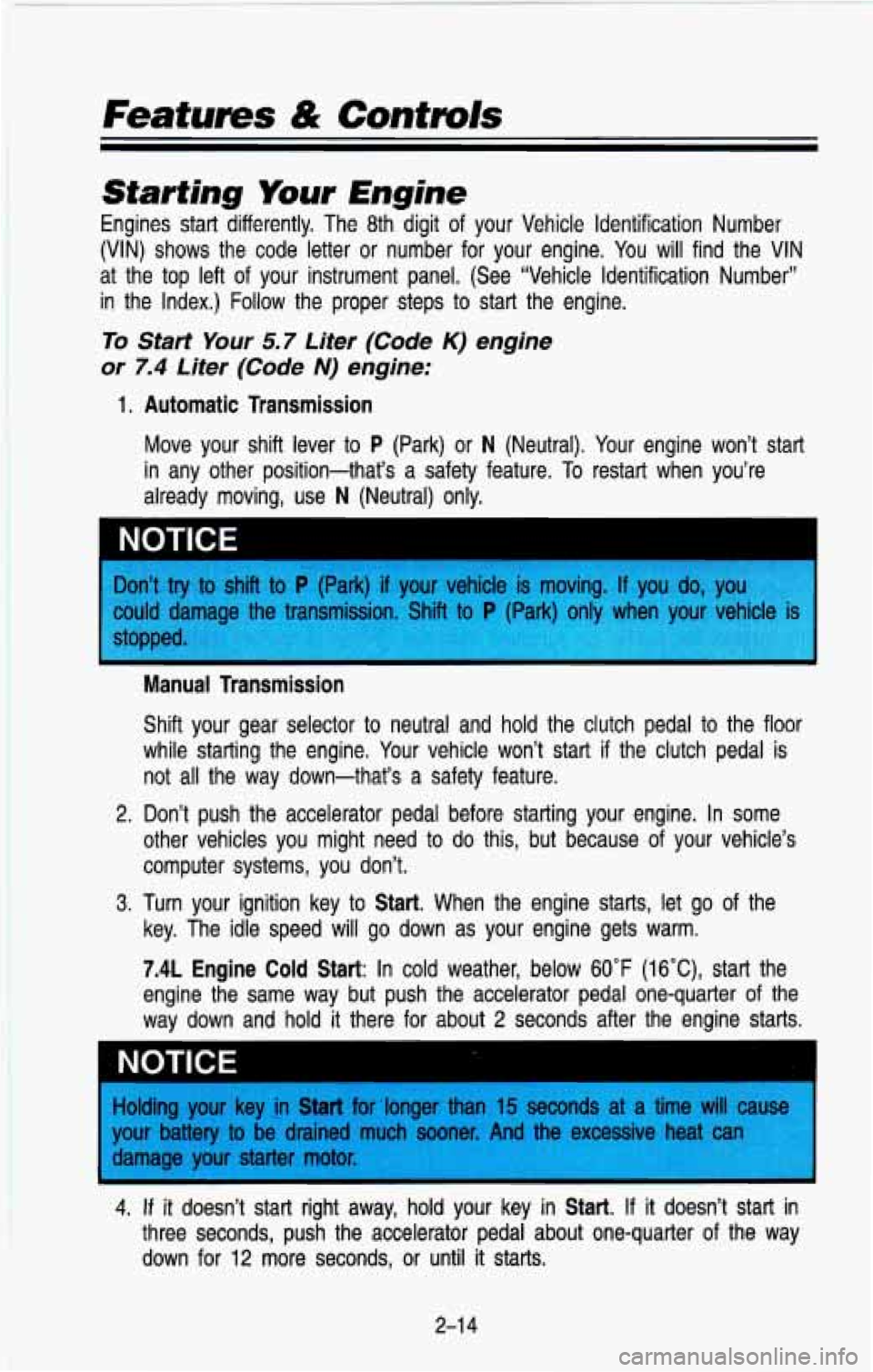
Features & Controls
kmrting Your Engine
Engines start differently. The 8th digit of your Vehicle Identification Number
(VIN) shows the code letter or number for your engine. You
will find the VIN
at the top left of your instrument panel. (See “Vehicle Identification Number\
”
in the Index.) Follow the proper steps to start the engine.
To Start Your 5.7 Liter (Code K) engine
or
7.4 Liter (Code N) engine:
1. Automatic Transmission
Move your shift lever to P (Park) or N (Neutral). Your engine won’t start
in any other position-that’s a safety feature. To restart when you’re
already moving, use
N (Neutral) only.
NOTICE I
Don’t try to shift to P (Park) if your vehicle is moving. If you do, you^^^^
p~&w$gp!
could damaa our P . icle is
stormed
Manual Transmission
Shift your gear selector to neutral and hold the clutch pedal \
to the floor
while starting the engine, Your vehicle won’t start if the clutch pedal is
not
all the way down-that’s a safety feature.
2. Don’t push the accelerator pedal before starting your engine.\
In some
other vehicles you might need to do this, but because of your vehicle’s
computer systems, you don’t.
key. The idle speed will go down as your engine gets warm.
7.4L Engine Cold Start: In cold weather, below 60°F (16°C)’ start the
engine the same way but push the accelerator pedal one-quarter \
of the
way down and hold it there for about 2 seconds after the engine starts.
3. Turn your ignition key to Start. When the engine starts, let go of the
Holding your key in
Start for ‘longer than 15 seconds at a time will cause
your battery to be drained much sooner. And the excessive he
damage
your starter motor.
4. If it doesn’t start right away, hold your key in Start. If it doesn’t start in
three seconds, push the accelerator pedal about one-quarter of the way
down for 12 more seconds,
or until it starts.
2-1
4
Page 82 of 386
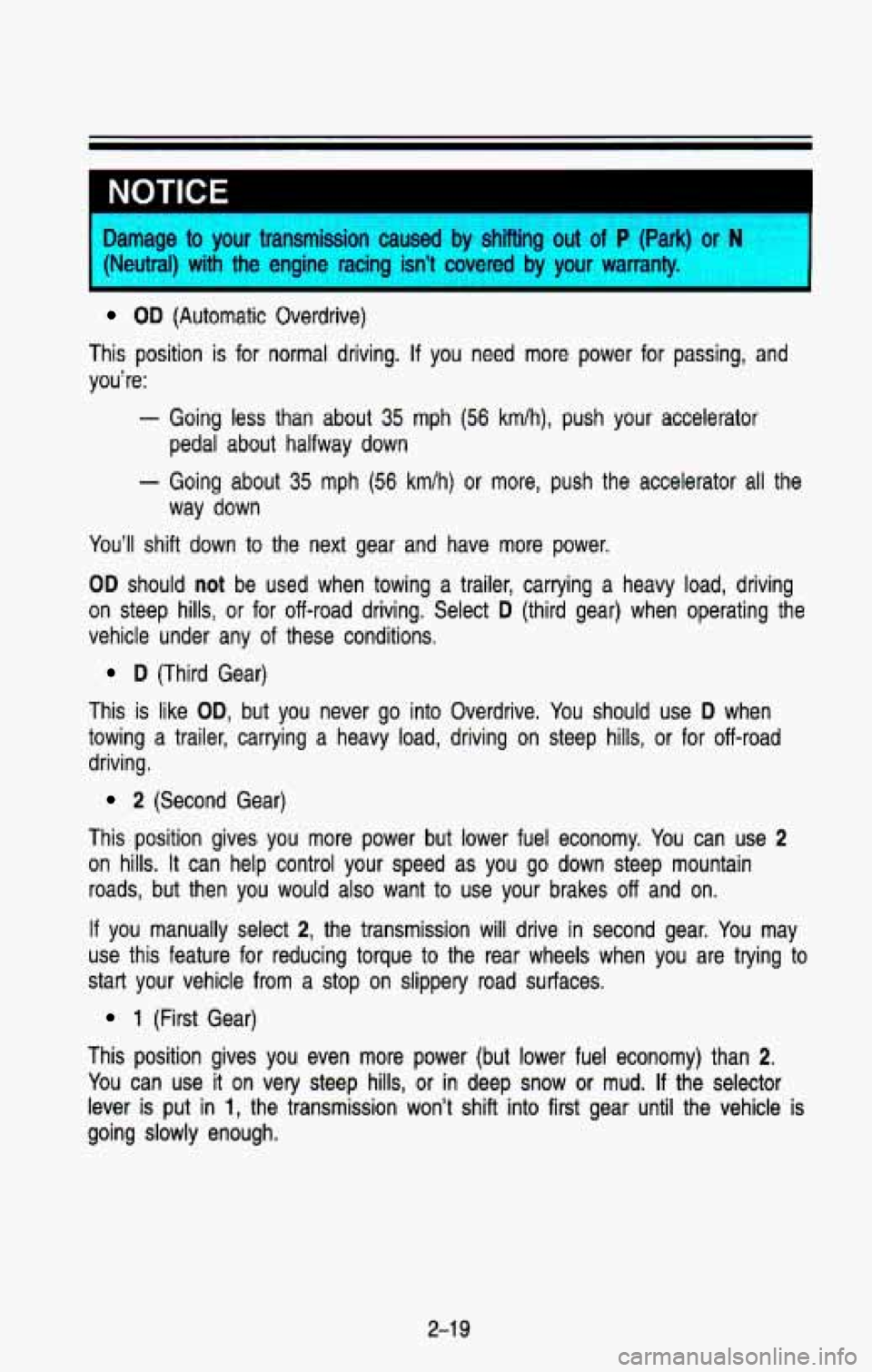
NOTICE
Damage to your transmission caused by shifting out of P (Park) or N
{Neutral) with the engine racing isn’t covered by your warranty.
OD (Automatic Overdrive)
This position is for normal driving.
If you need more power for passing, and
vou’re:
- Going less than about 35 mph (56 km/h), push your accelerator
pedal about halfway down
- Going about 35 mph (56 km/h) or more, push the accelerator all the
way down
You’ll shift down to the next gear and have more power.
OD should not be used when towing a trailer, carrying a heavy load, driving
on steep hills, or for off-road driving. Select
D (third gear) when operating the
vehicle under any of these conditions.
D (Third Gear)
This is like
OD, but you never go into Overdrive. You should use D when
towing a trailer, carrying a heavy load, driving on steep hills, or for off-road
driving.
2 (Second Gear)
This position gives you more power but lower fuel economy. You can use
2
on hills. It can help control your speed as you go down steep mountain
roads, but then you would also want
to use your brakes off and on.
If you manually select 2, the transmission will drive in second gear. You may
use this feature for reducing torque to the rear wheels when you are trying to
start your vehicle from a stop on slippery road surfaces.
1 (First Gear)
This position gives you even more power (but lower fuel economy) than
2.
You can use it on very steep hills, or in deep snow or mud. If the selector
lever is put
in 1, the transmission won’t shift into first gear until the vehicle is
going
‘slowly enough.
2-1 9
Page 87 of 386
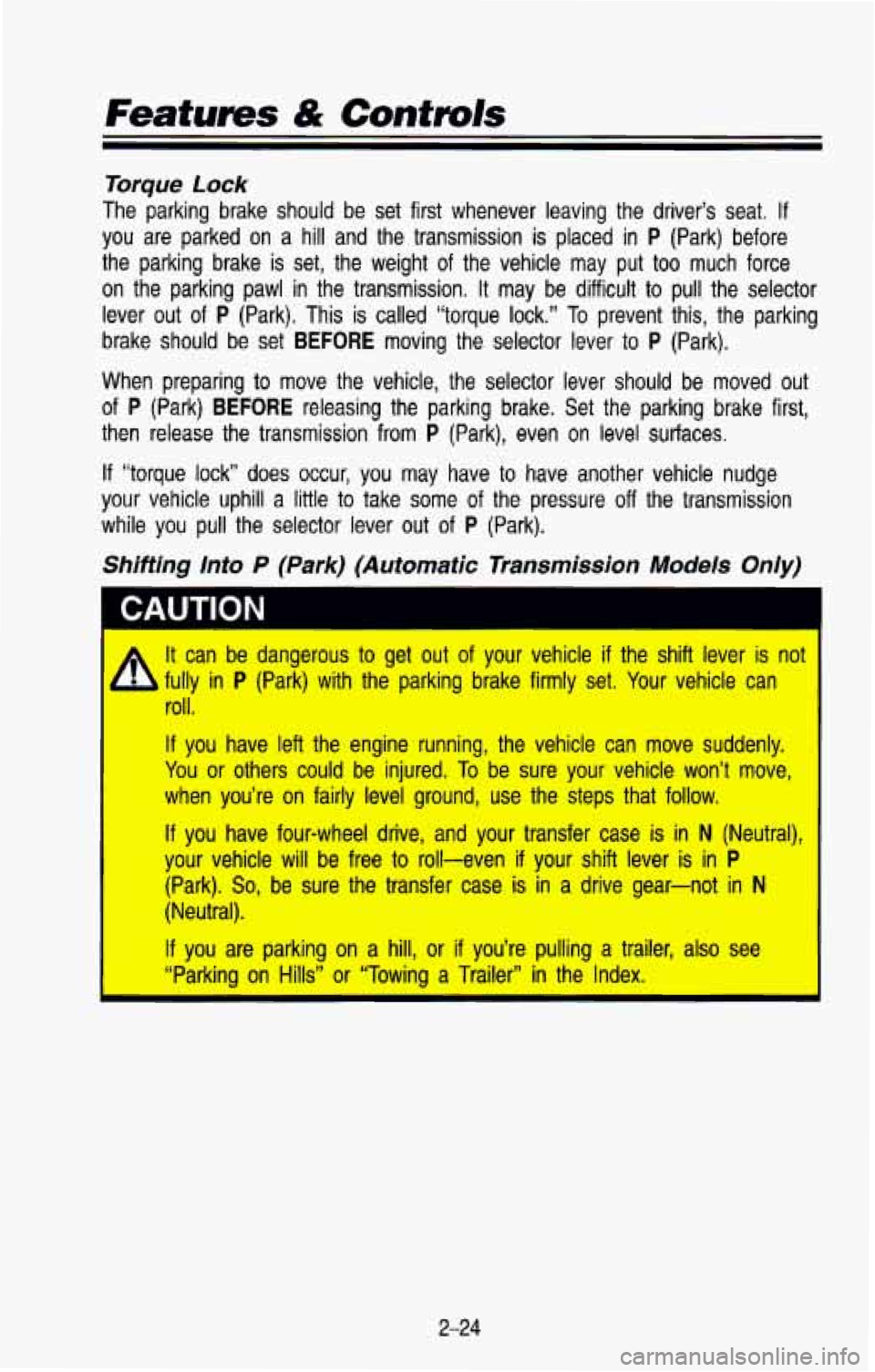
Features & Controls
Torque Lock
The parking brake should be set first whenever leaving the dri\
ver’s seat. If
you are parked on a hill and the transmission is placed in P (Park) before
the parking brake is set, the weight of the vehicle may put too much force
on the parking pawl in the transmission. It may be difficult to pull the selector
lever
out of P (Park). This is called “torque lock.” To prevent this, the parking
brake should be set
BEFORE moving the selector lever to P (Park).
When preparing to move the vehicle, the selector lever should be moved out
of P (Park) BEFORE releasing the parking brake. Set the parking brake first,
then release the transmission from
P (Park), even on level surfaces.
If “torque lock” does occur, you may have to have another vehicle nudge
your vehicle uphill
a little to take some of the pressure off the transmission
while you pull the selector lever out of
P (Park).
Shifting lnto P (Park) (Automatic Transmission Models Only)
It can be dangerous to get out of your vehicle if the shift lever is not I
A fully in P (Park) with the parking brake firmly set. Your vehicle can
roll.
If you have left the engine running, the vehicle can move suddenl\
y.
You or others could be injured.
To be sure your vehicle won’t move,
when you’re on fairly level ground, use the steps that foll\
ow.
If you have four-wheel drive, and your transfer case is in N (Neutral), I
your vehicle will be free to roll-even if your shift lever is in P
(Park). So, be sure the transfer case is in a drive gear-not in N
(Neutral).
If you are parking on a hill, or if you’re pulling a trailer, also see
I “Parking on Hills” or “Towing a Trailer” in the Index. I
2-24
Page 89 of 386

Features & Controls
Leaving Your Vehicle With the Engine Running (Automatic
Transmission Models Only)
A It can be dangerous to leave your vehicle with the engine running.
h Your vehicle could move suddenly if the shift lever is not fully in
P (Park) with the parking brake firmly set.
If you have four-wheel drive with a manual transfer case shift le\
ver
and your transfer case
is in N (Neutral), your vehicle will be free to
roll, even
if your shift lever is in P (Park). So be sure the transfer
case is in a drive gear-not in
N (Neutral).
And,
if you leave the vehicle with the engine running, it could
overheat and even catch fire. You or others could be injured. Don’t
I leave your vehicle with the engine running unless you have to.\
If you have to leave your vehicle with the englne runnmg, De sure your
vehicle is in
P (Park) and your parking brake is firmly set, before you leave
it.
If you have four-wheel drive with a manual transfer case shift le\
ver, be sure
that the transfer case is in a drive gear-not in
N (Neutral).
After you’ve moved the shift lever into the
P (Park) position, hold the regular
brake pedal down. Then,
see if you can move the shift lever away from
P (Park) without first pulling it toward you.
If you can, it means that the shift lever wasn’t fully locked \
into P (Park).
Parking Your Vehicle (Manual Transmission Models Only)
Before you get out of your vehicle, put your manual transmission in
R (Reverse) and firmly apply the parking brake.
If you have four-wheel drive, be sure your transfer case is in a drive gear.
Your vehicle could roll
if it isn’t.
If you are parking on a hill, or if your vehicle is equipped to tow a trailer,
see “Towing a Trailer” or “Parking on Hills” in the Index.
2-26
Page 95 of 386
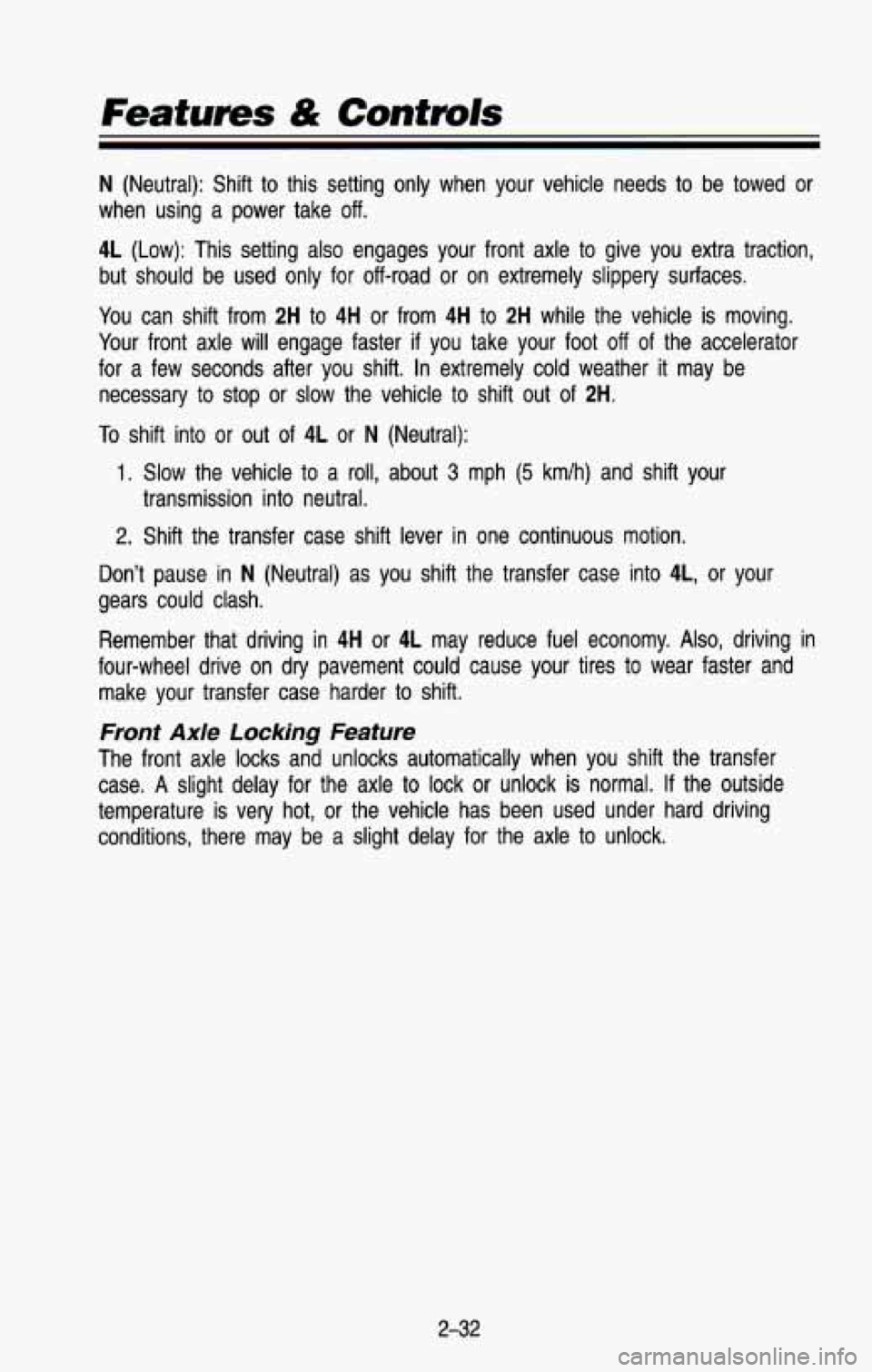
Features & Contmls
N (Neutral): Shift to this setting only when your vehicle needs to be towed or
when using a power take
off.
4L (Low): This setting also engages your front axle to give you extra traction,
but should be used only for off-road or on extremely slippery surfaces.
You can shift from
2H to 4H or from 4H to 2H while the vehicle is moving.
Your front axle will engage faster if you take your foot
off of the accelerator
for a few seconds after you shift. In extremely cold weather it may be
necessary to stop or slow the vehicle to shift out of
2H.
To shift into or out of 4L or N (Neutral):
1. Slow the vehicle to a roll, about 3 mph (5 km/h) and shift your
transmission into neutral.
2. Shift the transfer case shift lever in one continuous motion.
Don’t pause in
N (Neutral) as you shift the transfer case into 4L, or your
gears could clash.
Remember that driving in
4H or 4L may reduce fuel economy. Also, driving in
four-wheel drive on
dry pavement could cause your tires to wear faster and
make your transfer case harder to shift.
Front Axle Locking Feature
The front axle locks and unlocks automatically when you shift \
the transfer
case.
A slight delay for the axle to lock or unlock is normal. If the outside
temperature is very hot, or the vehicle has been used under hard driving
conditions, there may be a slight delay for the axle to unlock.
2-32